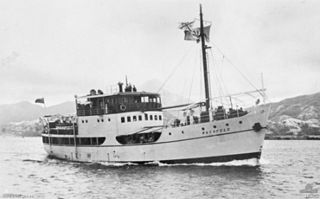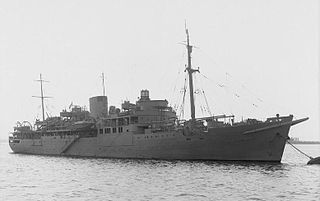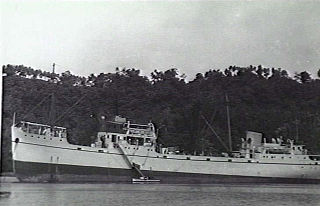
HMPNGS Lakekamu is Balikpapan-class landing craft heavy (LCH) operated by the Maritime Operations Element of the Papua New Guinea Defence Force (PNGDF). The vessel was one of eight built for the Royal Australian Navy (RAN) in the 1970s, and was commissioned into the RAN as HMAS Labuan in March 1973. Labuan was decommissioned in November 2014. She was transferred to the PNGDF for use as a training ship and was commissioned as HMPNGS Lakekamu in December 2014.

HMAS Kanimbla was a passenger ship converted for use as an armed merchant cruiser and landing ship infantry during World War II. Built during the mid-1930s as the passenger liner MV Kanimbla for McIlwraith, McEacharn & Co, the ship operated in Australian waters until 1939, when she was requisitioned for military service, converted into an armed merchant cruiser, and commissioned in the Royal Navy as HMS Kanimbla.

HMAS Manoora was an ocean liner that served in the Royal Australian Navy (RAN) during World War II. She was built in Scotland in 1935 for the Cairns to Fremantle coastal passenger run for the Adelaide Steamship Company. She was requisitioned by the RAN for naval service in 1939. Manoora was initially converted into an armed merchant cruiser (AMC), operating primarily in Australian, New Guinea, and Pacific waters, with deployments to Singapore and the Bay of Bengal.

MV Neptuna was a 5,952 ton cargo motor vessel. She was launched as MV Rio Panuco in 1924, renamed MV Neptun in 1931 and finally became MV Neptuna in 1935. She was sunk during the Japanese air raid on Darwin on 19 February 1942, during World War II.

The British Solomon Islands Protectorate was first declared over the southern Solomon Islands in June 1893, when Captain Herbert Gibson of HMS Curacoa, declared the southern islands a British protectorate.

A landing ship, infantry (LSI) or infantry landing ship was one of a number of types of British Commonwealth vessels used to transport landing craft and troops engaged in amphibious warfare during the Second World War. LSIs were operated by the Royal Navy, British Merchant Navy, Royal Canadian Navy, Royal Indian Navy, and Royal Australian Navy. They transported British Commonwealth and other Allied troops in sea assaults and invasions throughout the war.

The MV Cartela is an excursion vessel operating on the Derwent River in Hobart, Tasmania, Australia. She is now Australia's oldest continuously-licensed passenger vessel, although there are several older vessels still in service that have been restored after lengthy periods in dereliction.

The motor vessel MV Mamutu was an Australian merchant ship built in Hong Kong in 1938. She was of 300 gross tons, 113 feet (34.4 m) in length, and had a beam of 25 feet (7.6 m). She operated on an inter-island trade route for Burns Philp & Company, and at the outbreak of World War II, she was engaged in the evacuation of civilians ahead of advancing Japanese forces in New Guinea. The Mamutu sunk in August 1942 after being attacked by a Japanese submarine Ro-33 in the Gulf of Papua near Murray Island.
Orion Expedition Cruises (OEC) is a former Australian-based luxury expedition cruise line that operated the German-built 103 m, 4000 gross tonne MV Orion in Australasian and Antarctic waters.

USS Mizar (AF-12) was the United Fruit Company fruit, mail and passenger liner Quirigua that served as a United States Navy Mizar-class stores ship in World War II.

Sea Swift is a north Australian shipping company wholly owned by the Queensland Government Insurance Fund. It operates in Northern Australia, mainly servicing remote and regional communities in Far North Queensland and the Northern Territory. The company provides freight and passenger services, and maritime logistical support, operating container ships in addition to barges, tugs and landing craft.

HMAS Matafele was a small cargo and passenger vessel which was operated by Burns Philp from 1938 to 1942 and the Royal Australian Navy (RAN) from 1943 until she was lost with all of her crew as a result of an accident in June 1944.

USS Tuluran (AG-46) was under construction for the British at the Toledo Shipbuilding Company as the cargo ship War Bayonet in 1917 when requisitioned by the United States Shipping Board (USSB) for World War I service. The ship was launched and completed as Lake Superior. The Navy acquired the ship from the USSB with assignment to the Naval Overseas Transport Service (NOTS) with the identification number ID-2995. The ship was returned to the USSB which sold the vessel in 1926. The ship was renamed C. D. Johnston III and that vessel operated out of Oregon until again sold and based in San Francisco. Another sale resulted in the vessel being renamed Anna Shafer which was acquired by the War Shipping Administration (WSA) in 1942 and allocated to the Navy for World War II service.

MV Macdhui was a steel-hulled passenger and cargo motor ship built by Barclay Curle & Company at the Clydeholm Yard, Whiteinch, Scotland for Burns, Philp & Company, Limited, Sydney NSW, Australia. She was launched on 23 December 1930 and completed during March 1931. She operated with the company's Burns, Philp Line with service to Papua and New Guinea. She was sunk in 1942, as a result of damage suffered by being hit by bombs from Japanese aircraft, near Port Moresby.

MV Merkur was a 5,952 tons passenger cargo vessel that was requitioned into the Royal Australian Navy (RAN) during the Second World War as a victualling stores and supply vessel.

Sir Walter Randolph Carpenter (1877–1954) was an Australian-Canadian pearl hunting, trader, merchant, ship owner, airline industry leader and philanthropist of American ancestry active in the western Pacific from the 1890s through the 1940s.
HMAS Waree (W128) was a tug boat operated by the Royal Australian Navy (RAN) during World War II. She operated as a tug boat for the Waratah Tug and Salvage Company before being requisitioned by the RAN in 1942, and operating in northern Australia and Papua. She sank on 17 October 1946 off the New South Wales coast while sailing to Sydney from Thursday Island.

HMS Bulolo was a 6,267 ton passenger and cargo ship of the Burns, Philp Shipping Company operating in the South Pacific. In 1939 she was converted into an Armed Merchant Cruiser, then a Landing Ship Headquarters (LSH) in 1942. She directed the landings in North Africa, Sicily, Anzio and Normandy during World War II.

The MV Tulagi was a merchant ship built in 1939 and operated by the Burns Philp shipping line to carry cargo between the Pacific Islands and Australian ports. With the outbreak of World War II the Tulagi formed part of the Allied merchant navy fleet supplying the war effort throughout the Pacific and Indian Ocean theatres.

SS Matunga was a 1,618-gross register ton passenger-cargo ship, built by Napier and Miller, Glasgow for Mersey Steamship Co., Liverpool and originally named Zweena. Purchased by Burns Philp & Co. Ltd in 1910 for the British Solomon Islands service. Burns Philp was operating seven plantations in the Solomon Islands through subsidiaries - the Solomon Islands Development Company, the Shortland Islands Plantation Ltd and Choiseul Plantations Ltd.


























